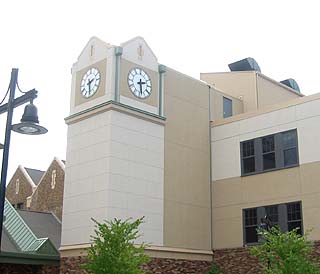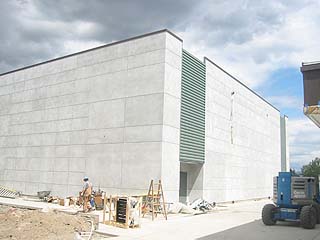|
Subscribe / Renew |
|
|
Contact Us |
|
| ► Subscribe to our Free Weekly Newsletter | |
| home | Welcome, sign in or click here to subscribe. | login |
Construction
| |
 |
August 12, 2004
Stucco makes a comeback
Northwest Wall and Ceiling Bureau

Photos courtesy Northwest Wall and Ceiling Bureau
Research has shown that stucco can help buildings survive earthquakes more easily. The versatile cladding is being used more often in school projects, including this one at Renton High School. |
Architects and designers have rediscovered an old standby for cladding our public institutions: portland cement plaster — aka stucco — has proven itself over decades of service in a variety climates.
Stucco is a mixture of portland cement, lime and sand, which produces a hard, durable and low-maintenance cladding that can be formed to a variety shapes.
Recently another benefit of stucco has been discovered. After the Northridge earthquake in California, engineers noticed that framed buildings clad in traditional three-coat stucco fared much better than other buildings, so they decided to run full-scale seismic tests on two-story homes with and without stucco.
The University of British Columbia conducted similar tests in which they re-created the Northridge and Kobe earthquakes.
On large shaker tables they built complete 2,000-square-foot, two-story buildings. The results from the testing led Graham Taylor, the engineer who headed the testing, to urge the Canadian government to "strongly consider using stucco on all essential buildings needing to provide services after a major earthquake."
Increased shear values

Plenty of options are available for finishing stucco. An acrylic finish coat, for example, allows for a wide range of colors. The stucco building in the photo is ready to paint.
|
A lath encased in portland cement provides remarkable increases in shear values. Shear is the deformation stress caused when parallel planes slide relative to each other to remain parallel, similar to the racking action of a seismic event.
Stucco's ultimate shear value is influenced by the connection of the lath to the framing members. Staples and nails are both allowed by code. Yet staples performed better in the full-scale seismic testing because they engaged the lath completely, preventing the lath wire from slipping out from under the head of the nail during the violent shearing action. Nails performed well when two nails were used — one each side of the wire lath.
After the seismic studies were complete, the buildings were rated on a four-level scale: unsurvivable, survivable with major repairs, survivable with moderate repairs and survivable with minor repairs.
Once subjected to strong earthquakes, the stucco-clad structures with lath applied consistently rated survivable with only minor repairs required. This testing should make designers seriously consider stucco a perfect choice for schools.
Old favorite, new twist
Recent concerns over moisture intrusion and mold are making everyone focus on water-management for the exterior.
A traditional, concealed-barrier stucco system will have two layers of building paper under the cement. When the wet plaster cement is applied, the building paper will wrinkle, pushing the plaster to form small channels that allow moisture to drain between the stucco and the building paper.
Faster drainage seems to be the new desire by most designers. Manufacturers are answering the call with a variety of drainage mats designed for use behind stucco.
These synthetic fiber mats are installed over the weather-resistive barrier to create a small cavity that allows water to drain to an exit point at the base of the wall. Rainscreen assemblies incorporate furring channels or straps to create a larger drainage space.
Variety in finishes
While most stucco we see is finished in a sand-finish type texture, there are options for finishing stucco.
Textures can range from smooth to very heavy. The textures available are only limited by the imagination and creativity of the designer and applicator. Stucco can be finished with an acrylic finish coat, which allows for a range of colors that can just about match any paint sample.
Dress it up
Another enhancement to stucco is the use of expanded polystyrene shapes over the stucco base coat to create shapes, plant-ons, quoins and cornices.
These foam trim items can be cut into any imaginable shape to add character to a stucco facade at an economical price. The shapes are adhesively applied over the cement base coat and then covered with a fiberglass mesh and polymer-enriched cement base coat.
The finish coat is then applied over the stucco and foam shapes. Even with the addition of foam shapes, this is still a traditional stucco assembly.
Stucco in the Northwest
Many people believe that stucco is only appropriate for the Southwest.
Stucco has been used with great success in our region for decades and certainly has proven itself. Portland cement needs water to cure and gain its ultimate strength. Cured stucco is unaffected by moisture and this makes stucco perfect for our region.
The stucco cement membrane is often mistakenly thought of as a porous membrane. Mixed and applied properly, the cement membrane is water-resistant and, yet, vapor permeable.
However, unlike the arid Southwest, we do get a significant amount rainfall and the stucco system must be designed, detailed and flashed to handle the anticipated wind-driven rains. Properly detailed, traditional stucco can meet even the most severe conditions that Seattle can dish out.
The Northwest Wall and Ceiling Bureau can help designers who are considering specifying a stucco cladding. Along with producing the "Stucco Resource Guide," complete with over 120 details, specifications and a quality check list, NWCB offers technical assistance in design, material and system selection.
NWCB contractors attend stucco seminars taught by the NWCB to ensure proper application for long lasting, durable, seismic and fire resistant cladding.
It is hard to find a more versatile cladding that can hold up to the abuse schools get and provide a more seismic safe building for our children than stucco. For more information visit the NWCB Web site at www.nwcb.org.
Mark Fowler is an architectural consultant at the Northwest Wall & Ceiling Bureau, a nonprofit construction trade organization.
Other Stories:
- Fast-track school projects require careful planning
- A little cooperation goes a long way
- Misunderstood fungus exacts a costly toll
- Restoring order to the school-design process
- A second wind for historic schools
- New vocational center a model for innovation
- Architects are from Mars, educators are from Venus
- Alternative school-funding models pay off
- Achieve good design within budget
- Research fuels UW space needs
- Schools to experiment with sustainability


